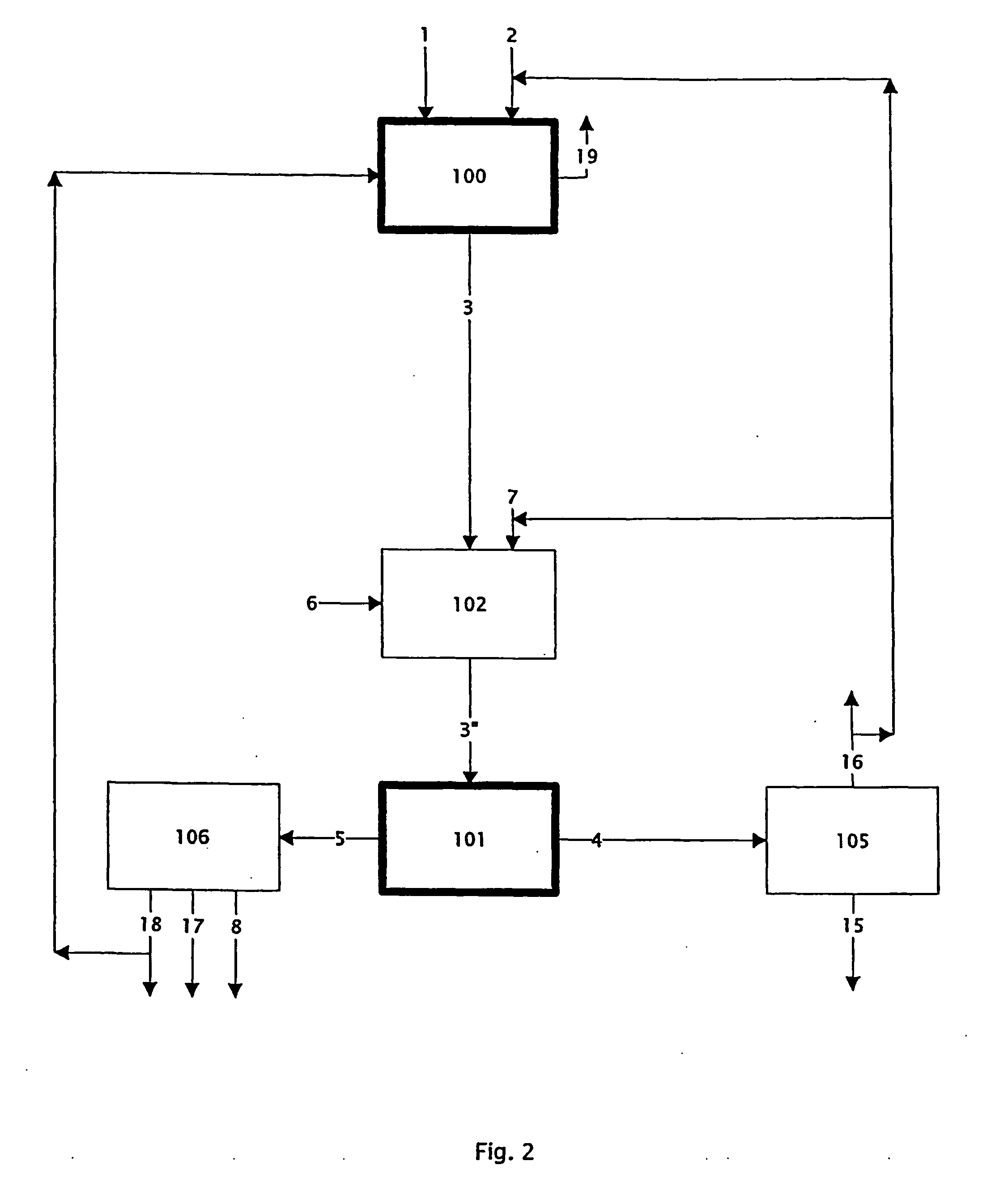Chloride melt process for the separation and recovery of zinc
a chloride melt and zinc technology, applied in the field of chloride melt process for the separation and recovery of zinc, can solve the problems of consuming a lot of zinc metal in the cementation step, the liquid purification step is rather complicated, and the leaching step is long and complicated, so as to avoid the melting of zinc cathodes, improve the control of residues, and improve the effect of reducing the number of sintering steps
- Summary
- Abstract
- Description
- Claims
- Application Information
AI Technical Summary
Benefits of technology
Problems solved by technology
Method used
Image
Examples
example 1
Chlorination of Zinc Blende
This example demonstrates the ability of the process to leach a blende concentrate (process step 100: reacting Zn bearing material with chlorinating agent).
2 kg of a molten solvent was prepared by mixing chloride salts in a quartz reactor. The composition of the solvent was: 51 mol % ZnCl2, 11.3 mol % PbCl2, 3 mol % CdCl2, 2 mol % KCl, 12.1 mol % NaCl, 17.4 mol % CaCl2, 2.4 mol % CuCl, 0.8 mol % BaCl2. The mixture was heated to 600° C. under nitrogen. 1.6 kg of a blende concentrate was gradually added to the melt. The blende contained 50.6 wt % Zn, 9.2 wt % Fe, 1.8 wt % Pb, 0.1 wt % Cd, 0.23 wt % Cu, 33 wt % S. Chlorine gas was introduced by a quartz injection tube located at the bottom of the reactor, at a rate of 500 cc / min during 13 h. Sulphur was evolved from the reactor and collected in a condenser.
In order to evaluate the chlorination, the resulting melt was dissolved in 5 l of a NaCl 5 M solution, which favours the dissolution of the formed ch...
example 2
Chlorination of an Oxide Feed
This example demonstrates the ability of the process to leach an oxide feed (process step 100: reacting Zn bearing material with chlorinating agent).
2 kg of a molten solvent was prepared by mixing chloride salts in a quartz reactor. The composition of the solvent was: 51 mol % ZnCl2, 11.3 mol % PbCl2, 3 mol % CdCl2, 2 mol % KCl, 12.1 mol % NaCl, 17.4 mol % CaCl2, 2.4 mol % CuCl, 0.8 mol % BaCl2. The mixture was heated to 600° C. under nitrogen. 1 kg of Waelz oxide was gradually added to the melt. The oxide contained 56 wt % Zn, 3.32 wt % Fe, 7.9 wt % Pb. Chlorine gas was introduced by a quartz injection tube located at the bottom of the reactor, at a rate of 500 cc / min during 10 h.
In order to evaluate the chlorination, the resulting melt was dissolved in 5 l of a NaCl 5 M solution, which favours the dissolution of the formed chlorides. The solid residue was filtered out of the solution and analysed for its base metals content. Table 2 shows the ext...
example 3
Fe(III) Chloride Elimination
This example demonstrates the ability of the process to eliminate iron from the melt (process step 103: volatilising Fe as Fe(III) chloride).
A melt was prepared by chlorination of 2 kg of zinc blende with chlorine gas, in 1.8 kg of molten solvent. The zinc blende and the molten solvent had the same composition as in Example 1. After the chlorination, the melt contained 4 wt % of Fe, which is too much to be blocked as Fe2O3 by addition of e.g. ZnO, as explained above.
Chlorine gas was injected in the melt at a flow rate of 500 ml / min during 6 h. The temperature of the melt was 620° C. The experiment was stopped when almost no brown fumes (indicating the presence of Fe(III) chloride) were produced anymore. The analysis of the melt showed that the residual Fe content was 0.21 wt %, and thus that 95.8% of the Fe had been eliminated. The final Fe content is well below the limit of 2 wt % and can thus be blocked as an oxide. In those conditions, the contam...
PUM
| Property | Measurement | Unit |
|---|---|---|
| temperature | aaaaa | aaaaa |
| temperature | aaaaa | aaaaa |
| temperature | aaaaa | aaaaa |
Abstract
Description
Claims
Application Information
 Login to View More
Login to View More - R&D
- Intellectual Property
- Life Sciences
- Materials
- Tech Scout
- Unparalleled Data Quality
- Higher Quality Content
- 60% Fewer Hallucinations
Browse by: Latest US Patents, China's latest patents, Technical Efficacy Thesaurus, Application Domain, Technology Topic, Popular Technical Reports.
© 2025 PatSnap. All rights reserved.Legal|Privacy policy|Modern Slavery Act Transparency Statement|Sitemap|About US| Contact US: help@patsnap.com



